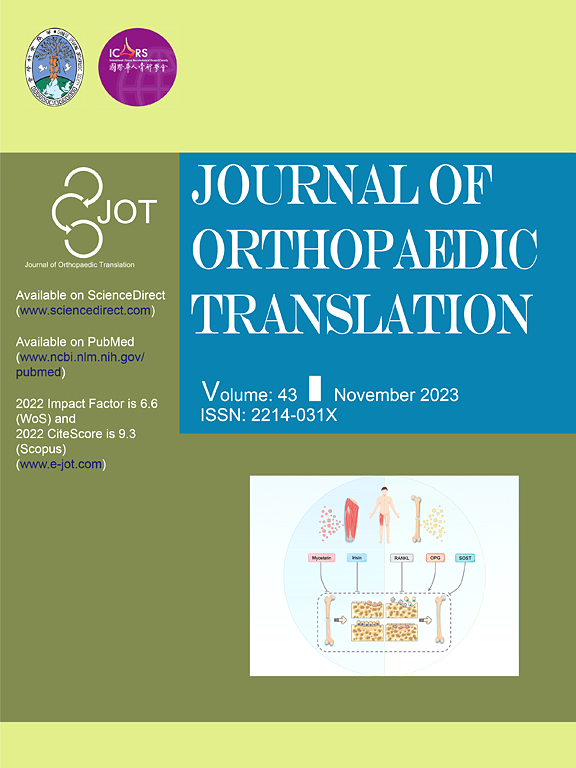Activation of LAMP1-mediated lipophagy by sulforaphane inhibits cellular senescence and intervertebral disc degeneration
IF 5.9
1区 医学
Q1 ORTHOPEDICS
引用次数: 0
Abstract
Background
Intervertebral disc degeneration (IDD) is a major cause of chronic low back pain, involving lipid dysregulation and cellular senescence in nucleus pulposus (NP) cells. However, the relationship between lipid accumulation and cellular senescence in IDD remain unclear. This study aims to investigate whether lipid accumulation promotes NP cell senescence and explore the role of LAMP1-mediated lipophagy in mitigating these effects.
Methods
Human and rat NP tissue samples were analyzed for lipid levels and senescence markers, including p16, p21 and p53. NP cells were treated with palmitic acid (PA) to induce lipid accumulation. Multi-omics analysis and machine learning were used to identify LAMP1 as a key regulator of lipid metabolism in NP cells. The effects of LAMP1 overexpression on lipid clearance and cellular senescence were evaluated in vitro. The natural compound sulforaphane (SFN) was applied to stimulate LAMP1-mediated lipophagy. LAMP1 knockdown was used to assess the role of LAMP1 in SFN-induced lipophagy and its impact on lipid accumulation and senescence. In vivo, SFN treatment was administered to rats with IDD induced by needle puncture. MRI, X-ray, and histological analysis were performed to evaluate the effects of SFN on disc degeneration, lipid accumulation, and senescence in NP tissue.
Results
Excessive lipid accumulation in degenerated NP tissues was observed, along with increased expression of senescence markers. Further experiments demonstrated that LAMP1 overexpression reduced lipid accumulation and senescence in NP cells. Notably, the natural compound sulforaphane enhanced LAMP1-mediated lipophagy, promoting lipid clearance and reducing senescence. In vivo, sulforaphane treatment in a rat IDD model reduced lipid accumulation and delayed IDD.
Conclusion
Our findings suggest that LAMP1-mediated lipophagy plays a crucial role in inhibiting NP cell senescence and that sulforaphane can slow the progression of IDD by activating LAMP1.
The translational potential of this article
This study indicates that the therapeutic effects of sulforaphane in mitigating lipid accumulation and senescence can provide an effective treatment strategy for delaying the progression of IDD in the future.

萝卜硫素激活lamp1介导的脂肪吞噬可抑制细胞衰老和椎间盘退变
背景椎间盘退变(IDD)是慢性腰痛的主要原因,涉及髓核(NP)细胞的脂质失调和细胞衰老。然而,IDD中脂质积累与细胞衰老之间的关系尚不清楚。本研究旨在探讨脂质积累是否促进NP细胞衰老,并探讨lamp1介导的脂质吞噬在减轻这些影响中的作用。方法分析人类和大鼠NP组织样本的脂质水平和衰老标志物p16、p21和p53。用棕榈酸(PA)处理NP细胞诱导脂质积累。通过多组学分析和机器学习,我们确定了LAMP1是NP细胞脂质代谢的关键调节因子。体外研究LAMP1过表达对脂质清除和细胞衰老的影响。应用天然化合物萝卜硫素(SFN)刺激lamp1介导的脂肪吞噬。LAMP1敲低被用来评估LAMP1在sfn诱导的脂质噬噬中的作用及其对脂质积累和衰老的影响。在体内,对针刺诱导的IDD大鼠给予SFN治疗。通过MRI、x线和组织学分析来评估SFN对NP组织椎间盘退变、脂质积累和衰老的影响。结果变性NP组织中脂质积累明显,衰老标志物表达增加。进一步的实验表明,LAMP1过表达减少了NP细胞的脂质积累和衰老。值得注意的是,天然化合物萝卜硫素增强了lamp1介导的脂质噬噬,促进脂质清除,减少衰老。在体内,萝卜硫素在大鼠IDD模型中治疗可减少脂质积累并延迟IDD。结论LAMP1介导的脂噬在抑制NP细胞衰老中起重要作用,萝卜硫素可以通过激活LAMP1来减缓IDD的进展。本研究提示,萝卜硫素在缓解脂质积累和延缓衰老方面的治疗作用可以为未来延缓IDD进展提供有效的治疗策略。
本文章由计算机程序翻译,如有差异,请以英文原文为准。
求助全文
约1分钟内获得全文
求助全文
来源期刊

Journal of Orthopaedic Translation
Medicine-Orthopedics and Sports Medicine
CiteScore
11.80
自引率
13.60%
发文量
91
审稿时长
29 days
期刊介绍:
The Journal of Orthopaedic Translation (JOT) is the official peer-reviewed, open access journal of the Chinese Speaking Orthopaedic Society (CSOS) and the International Chinese Musculoskeletal Research Society (ICMRS). It is published quarterly, in January, April, July and October, by Elsevier.
 求助内容:
求助内容: 应助结果提醒方式:
应助结果提醒方式:


